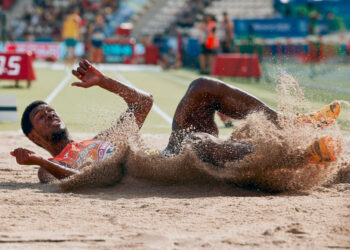Photos: Courtesy of the artist
The great writer Lezama Lima noted: “We can say that in a visual abstraction, we find nature, geometry, an excess of composition, movement as a quantity that is expressed, sentiment as refusing or suffering provocations from a point in infinity, hidden dangers of stylization through history or playful privileges on the seashore.”
That statement by the author of the novel Paradiso becomes a pretext for approaching the work of Rigoberto Mena, who, esthetically oriented toward abstractionism and with an overwhelming creative freedom based on an apparently heterogeneous and unequal mark, offers us his individual imagination.
Mena tries not to repeat himself and abstraction gives him the possibility and “the enjoyment of always doing completely new things. Sometimes even I don’t know how I did something, and everything turns into a surprise.”
Working with a set of colors, which he adjusts slightly according to the occasion, the painter and engraver — born in 1961 in Artemisa, Havana — is a self-confessed admirer of the Cuban abstract artists and also the maestros Piet Mondrian and Jackson Pollock, and he is recognized by critics as one of the most outstanding representatives of that current on the island.
But Mena entered the world of visual arts a little bit late in life: “At 19, I began visiting the Cultural Center in Marianao, which was doing excellent work in the community, and those were my first steps.” Subsequently, from 1985 to 1987, he was enrolled in the Higher Technical School for Design and Information, and from 1988 to 1989 he briefly took classes at the Higher Art Institute.
It was the start of the difficult 1990s — marked by a profound economic crisis — and everyone was looking for alternatives to open doors: “The objective was to work to sell,” he admits without any qualms or false shame. Initially, he became involved in the well-attended arts and crafts fairs that were held in the Plaza de la Catedral, and without having defined a solid esthetic project, began depicting nude women on bicycles and, at the same time, he made a series of works related to pre-Columbian cultures. That was when his work began to move in the direction of abstraction.
In recent times, Mena has felt very comfortable using large format art, or gigantism, and proof of that was in his exhibition Speaking in Tongues at the Museo Nacional de Bellas Artes in Havana late last year. At the same time, his paintings can be compared to a complicated symphony that includes entangled zones of silence, because it is emotion rather than theme that moves them.
He starts with an idea but talks about what is within, profound, the most private, intrinsic and even unconfessable essences, and for that reason, the area of rationality is left somewhat at a disadvantage: “If you ask what love is, no matter what the explanation is, it never approaches what is felt; if you talk about God, you always fall short,” he says.
Like most artists, Mena has gone through several stages, but he has been characterized by being very careful — and even cautious — in his use of color: sometimes he seems not to need them and they are even superfluous.
Moreover, his themes have to do with human beings, inner betterment, love, friendship: feelings that we all have, and in many ways, that define us. Perhaps for that reason, he offers us a tentative attachment between the purely abstract and the conceptual, which is why “there is a certain balance, although it is not easy to detect it because, at first sight, its looks like chaos and no rationality is seen,” he admits. Nevertheless, if a viewer’s trained eye is able to make the plunge into the depths of his work, he or she will find a delicate universe of points and counterpoints that he draws and blurs, composes and recomposes with delight, but also with skill and intelligence.
Lezama summed it up: nature, geometry, composition, movement, feelings, pain, denials, challenges, dreams…all of that (and more) are some of the foundations upon which abstraction is based: for that which is cultivated by Rigoberto Mena, nothing human is alien to him. That is his revealing contribution.




-60-x-50-cm-Impresión-lightjet-sobre-KODAK-Endura-papel-fotográfico_0-120x86.jpg)





